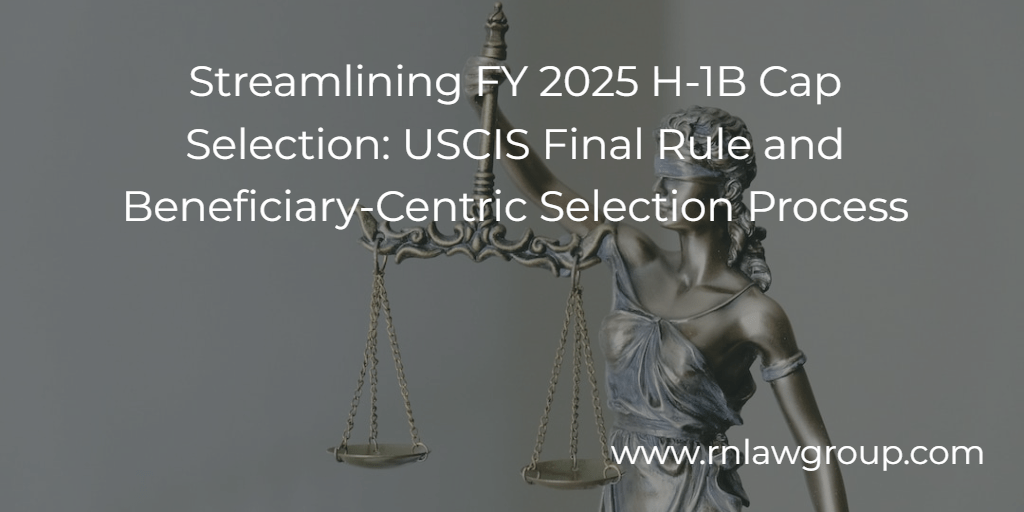
Streamlining FY 2025 H-1B Cap Selection: USCIS Final Rule and Beneficiary-Centric Selection Process
On January 30, 2024, the United States Citizenship and Immigration Service (USCIS) announced their final rule implementing significant codified changes to its regulations governing the H-1B visa registration selection process. Specifically, the Department of Homeland Security (DHS) has taken decisive steps to refine the H–1B visa system through the implementation of a beneficiary centric process for the Fiscal Year (FY) 2025 H-1B cap initial registration period set to run from noon EST on March 6, 2024 through noon EST on March 22, 2024.
This approach introduces key changes aimed at enhancing fairness, flexibility, and integrity in the H-1B registration and selection process through the implementation of integrity measures designed to safeguard the overall H-1B registration system from potential fraud caused by multiple registrations submitted on behalf of the same beneficiary. Further, the adoption of a beneficiary-centric selection process for H-1B registrations signifies USCIS’s notable shift in placing greater emphasis on the unique individual who will directly benefit from the H-1B visa rather than on each registrant employer’s submitted registration through a more equitable and streamlined method of identifying the unique beneficiary based on their valid passport or travel document.
How Will the Final Rule Beneficiary Centric H-1B Cap Registration Process Work?
Important Dates: The FY 2025 H-1B Electronic Registration initial period will open on March 6, 2024 at noon EST and close on March 22, 2024 at noon EST. USCIS will launch the new organizational accounts on February 28, 2024 to be used for electronic registration and online filing of the Form I-129 and Form I-907.
Registration Fee: Prospective petitioners seeking to file H-1B cap-subject petitions, including for beneficiaries eligible for the advanced degree exemption, must first electronically register and pay the associated $10 H-1B registration fee for each prospective beneficiary.
Beneficiary-Centric Electronic Registration Entry Details: Under the beneficiary centric process, registrations will be selected by unique beneficiary rather than by registration. USCIS will require registrants to provide valid passport information or valid travel document information for each beneficiary. The passport or travel document provided must be the one the beneficiary, if or when abroad, intends to use to enter the United States if issued an H-1B visa. Each beneficiary must only be registered under one passport or travel document. The biographic information required for each complete registration for each individual prospective beneficiary include the beneficiary’s information as listed on the applicable valid passport or travel document such as, full name, date of birth, valid passport/travel document number, country of birth and country of nationality. Additionally, the registration will require acknowledgement of the beneficiary’s master’s cap eligibility which is determined on whether a beneficiary has earned a U.S. master’s or higher degree from a U.S. institution of higher education. The electronic registration system will prohibit a beneficiary from being registered under more than one passport or travel document.
Beneficiary-Centric Selection Process Changes: Each unique beneficiary who has a registration submitted on their behalf will be entered into the selection process once, regardless of how many registrations are submitted on their behalf. If a beneficiary is selected, each registrant employer that submitted a registration on that beneficiary’s behalf will be notified of the beneficiary’s selection and will be eligible to file a petition on that beneficiary’s behalf during the applicable petition filing period. It is up to the individual beneficiary to choose the registrant employer who will ultimately file the H-1B cap petition on their behalf. However, each registrant employer will receive their selection notice without knowledge of any other registrant employer who also submitted a registration for the selected beneficiary. By setting this individual restriction of only one registration selection for each individual beneficiary selected, the beneficiary will not take up more than one allocated visa opportunity, even if multiple registrations were submitted on their behalf by different registrant employers.
For example, let’s assume beneficiary is registered using their valid passport number by Company A on March 7th. But the beneficiary has also secured job offers from and Company B, Company C, and Company D, and they have all also agreed to register the beneficiary and pay the $10 fee between March 6th and March 22nd. Regardless of the four separate registrant employers’ registration submitted using the beneficiary’s valid passport number, the beneficiary is only entered in the selection process once. If beneficiary is selected based on their passport number, each of the four registrant employers will receive a selection notification in their registrant account. The registrant employer can then contact and offer to file a cap-petition on behalf of the selected beneficiary per their individual internal filing policies.
By implementing the final rule beneficiary-centric H-1B selection process above, DHS is confident the process will reduce the potential for gaming the process to increase chances for selection and help ensure that each beneficiary has the same chance of being selected, regardless of how many registrations are submitted on their behalf.
Background on H-1B Registration
Since the initial implementation of the registration requirement for H-1B cap-subject petitions in 2020 for the FY 2021 cap season, USCIS has utilized the electronic registration process in efforts to better manage and streamline the annual 85,000 H-1B visa cap selection process.
The H–1B visa program, administered by USCIS, permits U.S. employers to temporarily hire foreign workers for specialized occupations requiring advanced knowledge and at least a bachelor’s degree. Established by the Immigration Act of 1990, Congress imposed an annual cap of 65,000 on beneficiaries eligible for initial H–1B visas, with an exemption of 20,000 visas for those holding master’s or higher degrees from U.S. institutions.
To manage the annual cap and enhance the selection process efficiency, USCIS introduced a random selection method for years of high demand. In a significant move, the Department of Homeland Security (DHS) implemented a registration requirement for H-1B cap-subject petitions in 2020 for the FY 2021 cap season. This innovative approach, established through the final rule in 2019, aimed to revolutionize the H-1B cap selection process. The primary goals were to enhance efficiency, reduce costs for employers filing H-1B cap-subject petitions, and manage the selection process more effectively with efficiency and fairness.
Under the electronic registration system, prospective petitioners (also referred to as registrants) seeking to employ H-1B cap-subject workers had to undergo a registration process. This process required basic information about the petitioner and each requested H-1B candidate such as full name, passport number with the option to select if no passport was available, country of birth and highest education level. The electronic registrations underwent a selection process, and only those with valid selected registrations were eligible to proceed with filing H-1B cap-subject petitions through the issuance of a selection notice.
Purpose of the Final Rule’s Beneficiary Centric Approach
The recent codified final rule announced by USCIS, serves a crucial purpose in addressing specific challenges and abuse within the H-1B visa registration process. The Department of Homeland Security (DHS) has identified a concerning trend marked by an increase in the number of beneficiaries associated with multiple registrations, along with a rise in the frequency of registrations submitted for beneficiaries by multiple registrant entities. The existing regulatory framework lacks a restriction on the number of registrations that can be submitted for a single individual by different registrants, leading to a vulnerability in the system. During the FY 2024 initial registration period, USCIS reported a concerning large number of eligible registrations for beneficiaries with multiple eligible registrations between registrant employers that seemingly may have tried to gain an unfair advantage in increasing chances for selection by working together to submit multiple registrations on behalf of the same beneficiary.
The primary objective of the final rule is to counteract this trend and promote the fair and orderly administration of the annual H-1B numerical allocations. The DHS expresses a strong interest in ensuring that the allocated 85,000 H-1B visas are awarded to petitioners genuinely intending to employ H-1B workers and to give each beneficiary registered only one visa allocation opportunity once selected. The concern arises from the misuse of the registration system, where some entities may exploit it as a placeholder or manipulate the selection process, potentially hindering the fair distribution of H-1B visas to those with legitimate employment intentions.
To address this issue, the DHS has decided to implement a beneficiary-centric selection process, a key component of the final rule. This approach is designed to structurally limit the potential for gaming the system by individuals or entities who might exploit the registration process for speculative reasons or strategic advantages in the selection process. By centering the selection process around the actual beneficiaries and their employment prospects based on the identifying factor of unique beneficiary’s passport or travel document number, the DHS aims to enhance the integrity of the H-1B registration system, ensuring that it aligns more closely with its intended purpose of facilitating the employment of skilled workers in the United States. The urgency emphasized in finalizing these changes stems from the need to promptly address the potential for abuse in the upcoming FY 2025 cap season, reflecting the DHS’s commitment to maintaining the integrity of the H-1B visa program.
For more guidance on the implantation of this final rule and the interface of the electronic registration system, we encourage potential beneficiaries, employers and representatives alike to utilize the USCIS upcoming national engagement tech talks and webinars, such as the FY 2025 H-1B Electronic Registration Process webinar hosted by USCIS on February 21, 2024 from 2:30 – 3:30PM EST.
Furthermore, the final rule addresses concerns related to the integrity of the H–1B registration process. By implementing measures designed to ensure the accuracy and reliability of the registration system, the DHS aims to bolster confidence in the H–1B visa program. These integrity measures are embedded in the new provisions, which are meticulously outlined and codified in the regulatory framework. This comprehensive approach to refining the H–1B registration process reflects a commitment to fostering a fair, transparent, and responsive system that aligns with the evolving needs of the U.S. workforce and economy.
By : Jeanetly Garcia
Jeanetly Garcia advises employers and individuals through all phases of the non-immigrant visa process. As an attorney in the H-1B Department at Reddy Neumann Brown PC she is experienced in filing nonimmigrant petitions and applications for immigrant benefits, as well as, responding to USCIS issued requests for evidence concerning an array of legal issues.

